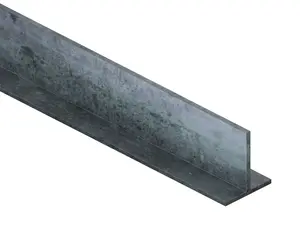Often referred to as a key element in construction and industry, T-bar forms the basis of many structures, providing them with stability and strength. Its characteristic "T" shape and unique steel properties make it indispensable in many projects.
Characteristics of T-bars
T-bar is a steel product with a specific "T" shape, which is used in various industries, especially in construction and mechanical engineering. It is characterized by exceptional resistance to load actions in the vertical and horizontal planes.
When characterizing a steel T-bar, it is crucial to understand its technical specifications, which determine its physical and mechanical properties. Width, height and wall thickness are the three basic parameters that define a given T-piece model. Due to their specific shape and structure, T-bars are characterized by good strength properties and resistance to the effects of dynamic and static loads.
The production of steel T-bars is based on several stages. To begin with, the steel is heated to the right temperature to make it soft and ductile. Then it passes through specially designed molds that give it the right shape. Depending on your needs, it can be a standard-sized T-bar or a customized T-bar. After the shaping process, the T-bar is cooled and then heat-treated to achieve the appropriate hardness and strength. In many cases, T-bars are additionally galvanized to increase corrosion resistance.
Features and advantages of T-bars
Features of T-bars:
- Shape in the form of the letter "T " - a characteristic design that determines their mechanical properties.
- Width, height and wall thickness - parameters that define different models of T-bars.
- Steel construction - made of high-quality steel, which ensures their durability and strength.
- Corrosion resistance - can be galvanized or coated with specialized coatings.
- Machinability - T-bars can be cut, welded and bent without losing their properties.
Advantages of T-bars:
- High strength - due to their structure they are resistant to loads in the vertical and horizontal planes.
- Saving material - compared to other sections, T-bars allow optimal use of steel while maintaining high strength.
- High durability - thanks to the use of high-quality steel and heat treatment, T-sections are characterized by a long service life.
- Ease of installation - the simplicity of the T-section shape allows quick and reliable installation in various types of structures.
Steel grades
Our offer includes closed T-bars made of S235JR (1.0038) and S355J2 (1.0577) steel.
S235JR steel (1.0038)
Features:
- Low carbon content.
- Contains small amounts of manganese.
- Good welding properties.
Advantages:
- Versatility - it is one of the most widely used steels in steel structures, due to its mechanical properties and ease of processing.
- Good weldability - it can be welded using most conventional methods.
- Economy - due to its availability and relatively low cost, it is the preferred material in many structures.
Disadvantages:
- Lower strength - compared to higher grades of S235JR steel, it has lower yield and strength limits.
- Limited corrosion resistance - without additional protection, such as painting or plating, it is susceptible to corrosion.
S355J2 steel (1.0577)
Features:
- Higher carbon content compared to S235JR.
- Better mechanical properties.
- Contains alloying additives, such as manganese, which increase its strength.
Advantages:
- High strength - due to its better mechanical properties, it is ideal for applications that require higher load resistance.
- Good weldability - although it contains more carbon than S235JR, it still retains good welding properties.
- Impact resistance - due to its structure, it is more resistant to impact and dynamic loads.
Disadvantages:
- Cost - it is more expensive compared to S235JR due to its advanced mechanical properties.
- Need for specialized processing - although it is well welded, welding S355J2 may require more specialized procedures than S235JR.
Applications of T-bars
T-sections are key components in many engineering and construction industries. Due to their unique mechanical properties and shape, they have a wide range of applications in various industries.
In the construction industry, steel T-bars are often used as a basic structural element. Thanks to its ability to carry loads in both the vertical and horizontal planes, T-sections are ideal for creating the framework of buildings, bridges or industrial halls.
In mechanical engineering, T-bars are an important component in machine structures, especially where rigidity and stability are needed. They are often used in industrial machinery such as presses, cutting machines and elevators.
In the energy sector, T-bars are used in transmission tower structures, supports and other load-bearing structures.
In the transportation industry, T-bars are used in the manufacture of railroad tracks, as well as in the construction of bridges and viaducts, providing durability and resistance to dynamic loads.
In addition to these main applications, T-bars are also used in many other sectors, such as shipyards, the chemical industry and heavy equipment manufacturing.
Advice for investors
- Analyze your needs - determine the exact specifications of the T-bars that are needed for your project. Take into account size requirements, thickness and mechanical properties.
- Selection of steel grade - based on the purpose of the T-bars, choose the appropriate steel grade.
- Technical documentation - make sure the supplier provides full technical documentation for the T-bars offered, including quality certificates and approvals.
- Supplier verification - choose reputable suppliers with industry experience and positive feedback from other customers.
- Transportation and storage - plan transportation and storage conditions of T-bars accordingly to prevent mechanical damage and corrosion.
- Post-delivery verification - upon receipt of T-bars, conduct a quality inspection, checking their dimensions and any damage to make sure they conform to the order.
Storage of T-bars
Proper storage of steel T-bars is key to maintaining their quality and functionality. Our recommendations:
- Horizontal storage - T-bars should be stored horizontally on level supports, allowing uniform weight distribution and avoiding bending or deformation.
- Protection from moisture - store T-bars in a dry place, away from direct contact with water. For outdoor storage, use tarps or other waterproof covers.
- Insulation from the ground - place T-bars on elevations (e.g., from wooden beams) to prevent direct contact with the ground, which can lead to corrosion.
- Separation of materials - if you store different types of metals, make sure they are properly separated to avoid galvanic corrosion.
- Regular inspections - systematically check the condition of stored T-bars for corrosion, deformation or other damage.
Did you know
- The first T-bars were introduced in the 19th century during the Industrial Revolution, when people began to look for more efficient and economical methods of building steel structures.
- The specific shape of T-sections was designed to provide optimal stress distribution, allowing them to carry loads simultaneously in the vertical and horizontal planes.
- Although T-beams are mainly associated with the construction industry, they are also used in other industries, such as the manufacture of steel furniture and decorative elements in interior design.
- T-sections are 100% recyclable. At the end of their useful life, they can be re-melted and used to manufacture new steel products.
T-sections - why with us?
At Moris steel wholesaler, we offer a wide range of T-bars of the highest quality, tailored to the individual needs of each company. Our team of experts provides professional service, technical advice and support at every stage of order processing. For the convenience of our customers, we offer a variety of flexible delivery methods, guaranteeing fast and timely delivery.
Take advantage of our wide range of T-bars. Feel free to consult with our specialists, who will be happy to help you choose the best solution.
FAQ
How much does a T-bar cost?
The price of a T-bar can vary depending on a number of factors, such as the type of hall (different grades of steel have different properties and production costs), dimensions (thicker or larger T-bars will have a higher price), suppliers (prices can vary from manufacturer to manufacturer and supplier to supplier), demand and supply, market conditions, etc.
How much does a meter of T-bar weigh?
The weight of one meter of T-bar depends on its dimensions and the type of steel from which it is made. To determine the weight of a running meter of T-bar, you need detailed information about its cross-section and steel grade.

